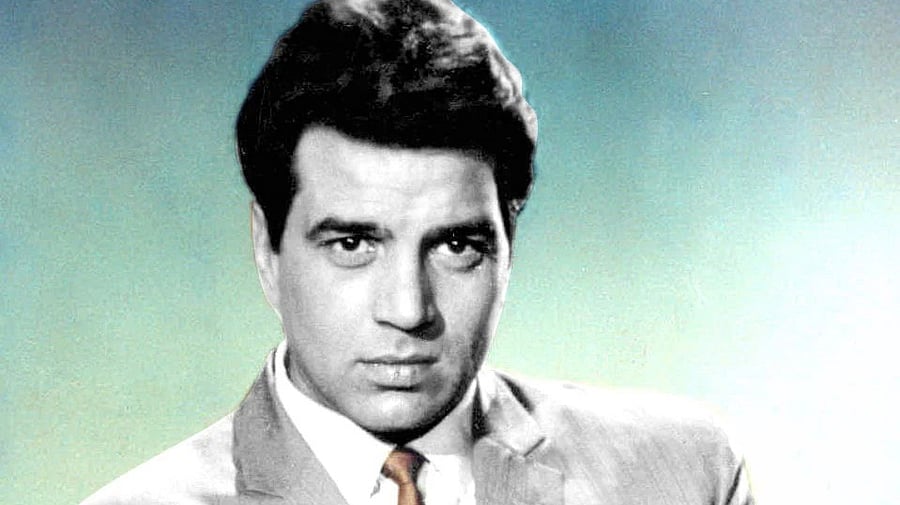
Dharmendra Deol 1935-2025
Dharmendra, who died on Monday at 89, embodied the classic matinee idol: the kind women swooned over and men wanted to be.
This was playfully acknowledged in his self-referential role in Hrishikesh Mukherjee’s Guddi (1971). And yet, there was something warm and relatable about this small-town Punjabi boy, whose tinsel town dreams were inspired by his icon Dilip Kumar’s film Shaheed (1948).
Dharmendra Deol was at the heart of some of Hindi cinema’s canon-defining films — Mera Gaon Mera Desh (1971), Seeta Aur Geeta (1972), Yaadon Ki Baaraat (1973), Chupke Chupke (1975), and Sholay (1975).
He bounced between genres and worked with filmmakers of every stripe: Bimal Roy, Arjun Hingorani, O P Ralhan, Dulal Guha, Pramod Chakravorty and Anil Sharma. With no formal training, he always maintained that acting was simply reacting.
Image-wise, he moved easily between the romantic aura of Rajesh Khanna, the anger and intensity of Amitabh Bachchan, and the pleasantness of Shashi Kapoor. He was also called Hindi cinema’s He-Man.
Solo hits, massive multistarrers such as Haqeeqat (1964) and The Burning Train (1980), debacles such as Shalimar (1978) and Razia Sultan (1983), stylish thrillers such as Ankhen (1968) and Charas (1976), massy entertainers such as Patthar Aur Payal (1974) and Pratiggya (1975), costume epics such as Dharam Veer (1977) and Raaj Tilak (1984), and plenty of B-grade outings such as Loha (1987) and Aatank (1996) dot his six-decade long career.
He shared screen space with the likes of Ashok Kumar, Amitabh Bachchan, and Vinod Khanna.
He acted opposite seasoned women actors Nutan and Meena Kumari, contemporaries Asha Parekh and Sharmila Tagore, and newcomers like Rakhee. His pairing with co-star Hema Malini, with whom he did over 30 films, is the stuff of celluloid legend.
Three of his children — Sunny, Bobby, and Esha, and nephew Abhay Deol, are a part of showbiz, with grandsons Karan and Rajveer following in his footsteps.
Dharmendra launched films like Betaab (1983), Ghayal (1990), and Socha Na Tha (2005), backing filmmakers Rajkumar Santoshi and Imtiaz Ali. He dabbled in politics briefly, doing a stint as a BJP MP, and his political life remained largely uneventful.
But before he became the poster boy for hot-blooded masculinity, Dharam’s career began as a sensitive romantic lead. Heroine-oriented films like Bandini (1963) and Anupama (1966) earned him a loyal female following. Even in lead roles like Jeevan Mrityu (1970) and Phool Aur Patthar (1966), and his 1969 pièce de résistance Satyakam, where he plays an idealistic engineer, he displayed a consistent gentleness and sincerity to his characters.
A big part of the Hindi film hero’s magic is how well he works with its music. ‘Pal pal dil ke paas’ and ‘Aapke haseen rukh’ light up with his quiet yearning, as do romps like ‘Main Jatt yamla’ and ‘Koi haseena’ with his goofiness. ‘Gaadi bula rahi hai’ — Anand Bakshi’s life-affirming train song from Dost (1974) — relies entirely on Dharmendra’s magnetic screen presence. Also consider the melancholic solemnity of his performance in Anupama’s ‘Ya dil ki suno’.
The actor had a natural gift for comedy. His double role in Ghazab (1982) as the buck-toothed, slow-witted ‘ghost’ and his dashing twin remains among his most endearing performances. As the loveable rogue Veeru, he brings with his iconic gags a breather in the brutal world of Sholay. No one tapped into his soft, humorous side better than Hrishikesh Mukherjee and Basu Chatterjee. Both reimagined the brawny star as a brainy academic with a flair for mischief. The jolly botany professor masquerading as a suddh Hindi-speaking chauffeur in Mukherjee’s Chupke Chupke is a classic; the liberal, easygoing Sanskrit lecturer smitten with an uptight chemistry teacher in Chatterjee’s Dillagi (1978) is an underrated gem.
With the ’80s came nearly two decades of endlessly angry titles like Jeene Nahi Doonga (1984) and Main Intequam Loonga (1982) and a long spell of shoddy B-grade movies. Ironically, some of these cookie-cutter actioners are Dharmendra’s most profitable films, sealing his image as a massy star who still draws the crowds in small centres.
Dharmendra’s gregariousness, goodwill, and reputation as an unassuming, all-heart person are well-known. These aspects strike a chord with both the industry and the public so much so that his drinking problem and scandalous romantic entanglements as a family man — an alleged link with Meena Kumari and his second marriage to Hema — are overlooked as minor blemishes.
The versatile star has stayed a favourite with contemporary filmmakers who understood his significance in Hindi cinema culture. His cameo in Sriram Raghavan’s neo-noir thriller Johnny Gaddaar (2007) unfolds with nostalgic hat-tips. The actor was also a part of Raghavan’s upcoming war drama Ikkis, due for release in December. It will feature perhaps his last screen appearance. Karan Johar cast him as a shayari-loving elder with fading memory, reunited with a long-lost love in Rocky Aur Rani Kii Prem Kahaani (2023). Dharmendra serenading Shabana Azmi with Bollywood classics, including his famous song ‘Aaj mausam bada beimaan’ from Loafer (1973), was among the film’s standout moments.
In recent years, Dharmendra’s social media presence became a window to his life and times. The warmth with which he interacted with fans, shared vignettes of his farm life and fitness routine, his open affection for his children, and fond recollections about colleagues and friends — many of whom are no longer around—paint a portrait of a sentimental, grateful man who aptly called himself ‘aap ka Dharam’—a people’s star through and through.
(The author is a freelance journalist)